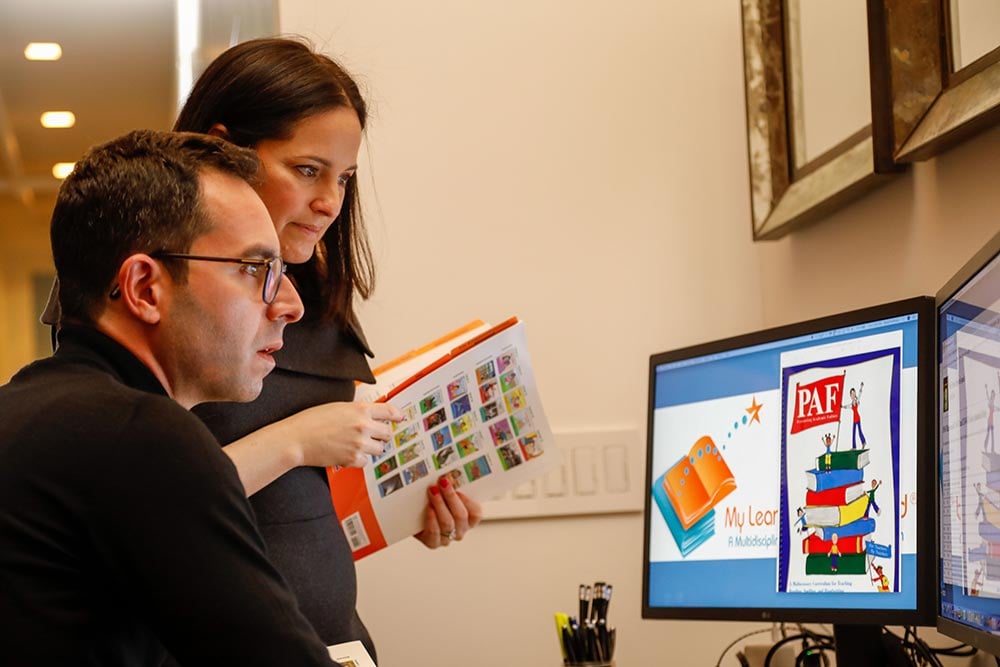 Preventing Academic Failure, or PAF, is a multisensory, Orton-Gillingham based reading intervention program that integrates reading, writing, and spelling. PAF was developed by Phyllis Bertin, Director of Reading at the Windward Teacher Training Institute, and Eileen Perlman, former Director of the Reading Initiative at The Churchill School and Center. The principles and practices of PAF are incredibly beneficial to students with dyslexia and language-based learning disabilities as well as younger students learning to read. The specific goals of the program, or intervention, are to give students the tools to read cohesively, write fluidly, and spell with ease. PAF was designed for classroom instruction but can be modified for private tutoring. While it is not a scripted program and strict set of rules, it is a carefully designed scope and sequence with specific methodologies and materials.
Preventing Academic Failure, or PAF, is a multisensory, Orton-Gillingham based reading intervention program that integrates reading, writing, and spelling. PAF was developed by Phyllis Bertin, Director of Reading at the Windward Teacher Training Institute, and Eileen Perlman, former Director of the Reading Initiative at The Churchill School and Center. The principles and practices of PAF are incredibly beneficial to students with dyslexia and language-based learning disabilities as well as younger students learning to read. The specific goals of the program, or intervention, are to give students the tools to read cohesively, write fluidly, and spell with ease. PAF was designed for classroom instruction but can be modified for private tutoring. While it is not a scripted program and strict set of rules, it is a carefully designed scope and sequence with specific methodologies and materials.
PAF explicitly and systematically teaches alphabetic principle, higher-level word analysis skills and comprehension strategies. The goal is to instruct with minimal frustration and maximum success for teachers and students alike, leading to mastery and enhanced self-esteem for each participating student. This multisensory approach is evidence-based practice and proven to support the struggling reader. There are explicit phonics lessons, an instructional scope and sequence, oral reading exercises, repeated readings, decoding, and integration of comprehension, writing, and spelling strategies. By taking each of these components into consideration and systematically planning instruction, struggling readers, writers, and spellers will begin to feel successful and excited about reading and writing. PAF includes an instructional approach to handwriting and encourages students to use Skywriting as a kinesthetic reinforcement.
A master teacher differentiates each lesson in his or her classroom or private tutoring sessions. The PAF program supports teachers in delivering differentiated lessons by incorporating multisensory practices. The multisensory approach is one that accesses the visual, auditory, and kinesthetic strengths of students within each lesson, providing them with three modalities to approach the literacy task at hand.
Written by: Editorial Team, My Learning Springboard, Inc. Built into the Preventing Academic Failure (PAF) reading curriculum is a handwriting program that incorporates a kinesthetic approach to instructing handwriting, but not just with a pencil in hand! SkyWriting is a way for students to
Built into the Preventing Academic Failure (PAF) reading curriculum is a handwriting program that incorporates a kinesthetic approach to instructing handwriting, but not just with a pencil in hand! SkyWriting is a way for students to  I taught High School and Middle School for nine and a half years and I can safely say that the hardest part of the school year for students and teachers are the first days. This is when all of the routines are set up, all expectations are made clear, and when kids get their chance to make first impressions. A student who kept up with schoolwork over the summer has more advantages than you would expect.
I taught High School and Middle School for nine and a half years and I can safely say that the hardest part of the school year for students and teachers are the first days. This is when all of the routines are set up, all expectations are made clear, and when kids get their chance to make first impressions. A student who kept up with schoolwork over the summer has more advantages than you would expect. Parents are often anxious about their children’s reading skills before they even know all their letters. Preschools vary a great deal in the amount of structured early literacy instruction offered. Some preschools have structured, explicit “letter of the week” type activities and teach each letter in isolation. Other preschools offer a more play based approach–weaving letters and literacy into each activity organically. Regardless of approach, parents still worry about setting the groundwork for reading success in the future. What can parents do to prepare very young children to be successful readers?
Parents are often anxious about their children’s reading skills before they even know all their letters. Preschools vary a great deal in the amount of structured early literacy instruction offered. Some preschools have structured, explicit “letter of the week” type activities and teach each letter in isolation. Other preschools offer a more play based approach–weaving letters and literacy into each activity organically. Regardless of approach, parents still worry about setting the groundwork for reading success in the future. What can parents do to prepare very young children to be successful readers? So you’ve started
So you’ve started